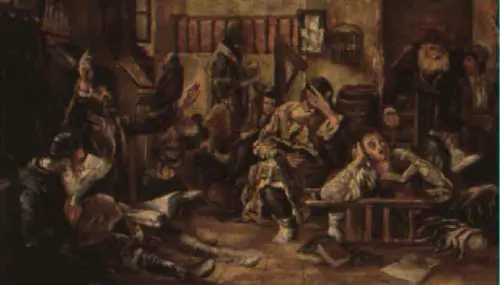BS”D
Tisha B’Av is a day when we mourn over the many tragedies that befell the Jewish people at this time of year- especially the destruction of the Beis HaMikdash. But how do we relate to this day in our generation on a practical level?
Even if we would try to learn all we could about the Beis HaMikdash- what it looked like, the miracles that occurred there, the services and sacrifices that were performed, etc- we still would have no idea what the experience was really like. Though some may be able to connect to a feeling of loss, is there anyone among us today who can say with confidence that he or she really knows what it is that we lost? We are very far removed from such an existence.
So the question is, given that this is the reality, what does HaShem expect of us?
..
Tisha B’Av: Over What Are We Mourning?
Though we say we are mourning the physical destruction of the Beis HaMikdash, it’s not really the building itself that we cry over. The spiritual reality that came with it was a much greater loss. When the Beis HaMikdash stood, those who wanted to express thanks to HaShem, those who wanted to come closer to HaShem, those who had fallen and wanted to do teshuva, all came to the Beis HaMikdash with offerings. In addition, all males were required to come to the Beis HaMikdash during the Yomim Tovim of the Shalosh Regalim: Pesach, Shavuos, and Sukkos. These celebrations, which revolve around the yearly agricultural cycle, helped to ensure that the Jewish people stayed connected to their Creator.
itself that we cry over. The spiritual reality that came with it was a much greater loss. When the Beis HaMikdash stood, those who wanted to express thanks to HaShem, those who wanted to come closer to HaShem, those who had fallen and wanted to do teshuva, all came to the Beis HaMikdash with offerings. In addition, all males were required to come to the Beis HaMikdash during the Yomim Tovim of the Shalosh Regalim: Pesach, Shavuos, and Sukkos. These celebrations, which revolve around the yearly agricultural cycle, helped to ensure that the Jewish people stayed connected to their Creator.
At every stage and situation in life, whenever an individual came to the Beis HaMikdash, there were two things that happened:
- They experienced an open revelation of HaShem’s Presence, since, as Chazal tell us, there were numerous miracles that occurred there (Avos 5:5).
- They had the opportunity to physically “present” themselves to HaShem, so to speak. The desire to come closer to HaShem on their end, meant also that HaShem came closer to them on His end. This means they received greater Sciata D’shamaya in their lives at their current place and level.
It’s this two-way experience that we no longer have, and it is over this that we really mourn.
.
The Potential Beis HaMikdash Still Stands
But, the truth is that the Beis HaMikdash was really a mashal. Chazal tell us that the Beis HaMikdash was modeled on the perfect man as well as on the Jewish home. The original plan before the sin of the Golden Calf was that HaShem would dwell within our hearts and within our homes, as it says
וְעָשׂוּ לִי מִקְדָּשׁ וְשָׁכַנְתִּי בְּתוֹכָם
Make for Me a Sanctuary, and I will dwell in their midst
Shemos 25:8
In other words, the real Beis HaMikdash, the real dwelling place of HaShem in this world, is within the heart of every Jew and within the walls of Jewish homes. For this reason וְשָׁכַנְתִּי בְּתוֹכָם can also be translated as, “I will dwell within them.”
In davening we say,
אַשְׁרֵי יושְׁבֵי בֵיתֶךָ
Praiseworthy are those who dwell in Your House
Rav Shimshon Raphael Hirsch explains that this is referring to the person who lives his or her normal, day-to-day life in the House of HaShem. This is an individual who is connected at every moment to HaShem- during the ups and the downs, the times of joy and the times of pain. When we strive to dwell in HaShem’s House at every moment in life then the result is that He simultaneously dwells within us.
Today, on Tisha B’Av we can mourn the fact that there are places within ourselves where we lack this connection. When Chazal tell us, “Every generation that Beis HaMikdash is not built, it is as if destroyed anew…” (Yerushalmi Yoma 1:6a), they were not just referring to the physical building, but to the very personal relationship the majority of the Jewish people have with HaShem.
..
Teshuva Through Simcha While Mourning?
One last point to bring this all together… Chazal tell us that the three weeks, and the month of Av in particular, are days that are set aside for teshuva. But that leaves us with a question: how can a person do teshuva at a time of mourning and sadness, since Chazal tell us that HaShem’s Presence will not rest on someone who is not b’simcha (Rambam Hilchos Yesodei Hatorah 7:4), and true teshuva cannot happen unless we recognize that HaShem Himself is right there helping us through the process.
A hint to the answer comes from an amazing insight of the Chasam Sofer. According to Chazal
משנכנס אב ממעטים בשמחה
The Chasam Sofer explains that the month of Av is a time to stop and reflect. It’s a time when we are ממעטים, we “reduce” the activities that create distractions in our lives- whether joyous or otherwise. By doing so we are more able to focus on and connect to the tzar of the Churban Beis Hamikdash- both on a physical and spiritual level. But at the same time, we should do all of this בשמחה, in joy and not in sadness.
How so?
The purpose of any tzar or nisayon that HaShem sends us is to remember that HaShem is right there behind all difficulty and suffering ( עִמּוֹ–אָנֹכִי בְצָרָה ) and that the experience itself is meant to bring us closer to ourselves, to emes, and to HaShem. This realization alone can (and ideally should) bring with it a renewed feeling of simcha!
May we merit to recognize HaShem through all the difficulties and nisayonos, and may we truly merit to bring the Moshiach and rebuild the Beis HaMikdash speedily in our days!


